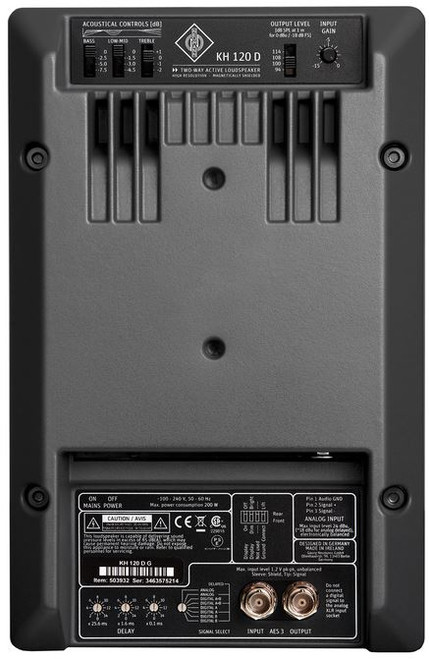- Main Features:
- Powerful titanium fabric dome
- Low-distortion high-frequency reproduction
- Elliptical Mathematically Modelled Dispersion™ (MMD™) waveguide
- Smoother off-axis response,
- More forgiving of diverse acoustical environments
- Composite sandwich cone
- Damping of break-up modes
- Long throw bass driver
- Low distortions at high sound levels
- Two-color + dimmable Neumann logo
- Displays operation status and activation of the extensive protection system
- Robust metal grille
- Protects against mechanical damage
- Large front panel ports
- Reduced bass compression and easier to mount in tight spaces such as OB vans
- Compact aluminum cabinet (magnetically shielded)
- Minimizes resonances, better heat dissipation, long life
- Wide horizontal dispersion
- Freedom of movement across the mixing console
- Narrow vertical dispersion
- Reduces reflections off the mixing console
- One-piece front panel with no discontinuities
- Reduced diffraction and smoother frequency response
- Powerful analog amplifiers with large headroom
- Improved transient response
- Production consistency
- Any KH 120 is “pair-matched” to any other KH 120
- 4-position bass, low-mid and treble acoustical controls
- More control in diverse acoustical environments
- Wide range input gain and output level controls
- Easier interfacing with signal sources
- New mounting hardware options
- More flexibility in mounting cabinets in more diverse locations
- Display dimmer
- For low lighting level conditions or behind the screen applications
- Ground lift
- Reduced noise in electrically noisy environments and over-comes ground loops
- Universal switched-mode power supply (100 … 240 V)
- One version works in any country and robust to poor quality mains supply
- Separate woofer and tweeter electronic peak limiters and thermal-protection circuitry
- High reliability
- Analog XLR input
- Compatible with any analog line signal
- Digital BNC input and buffered BNC output For flexible and trouble-free digital interconnectivity (24 bit, 192 kHz, AES3 and S/P-DIF) Lipsync delay (0 … 10/12 frames)
- To align audio and video signals Time-of-flight delay (0 … 400 ms)
- To compensate for listening distance differences



